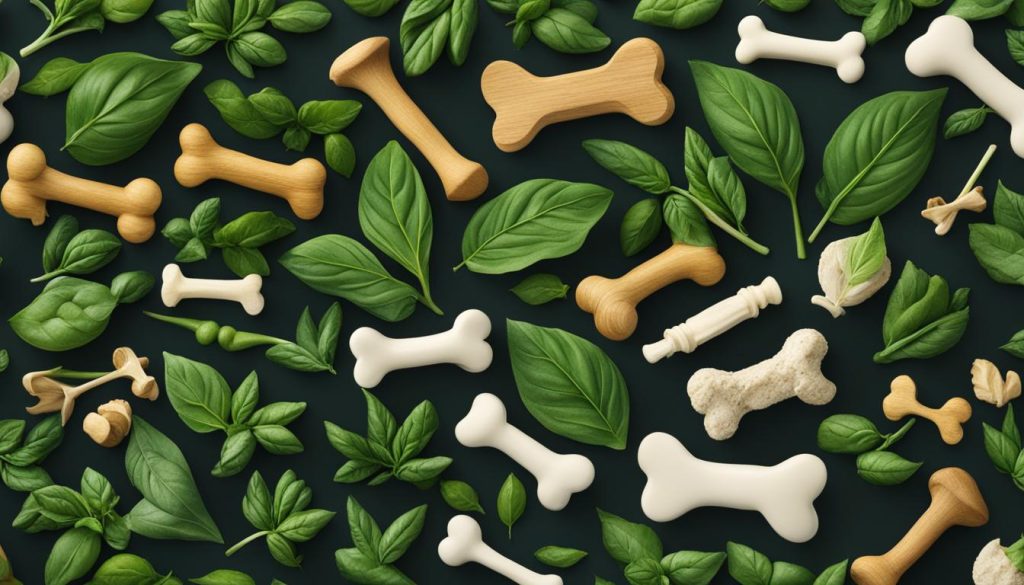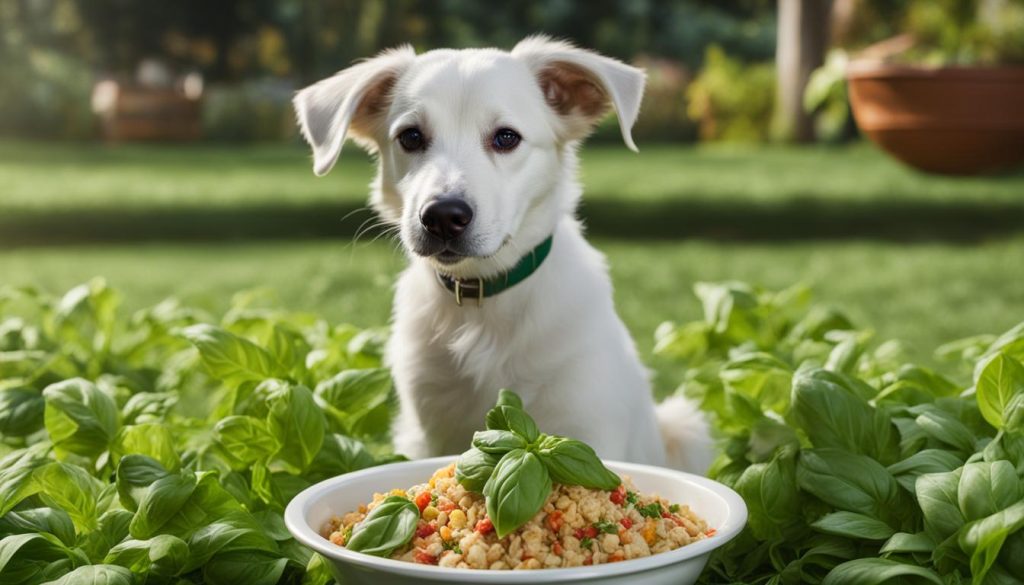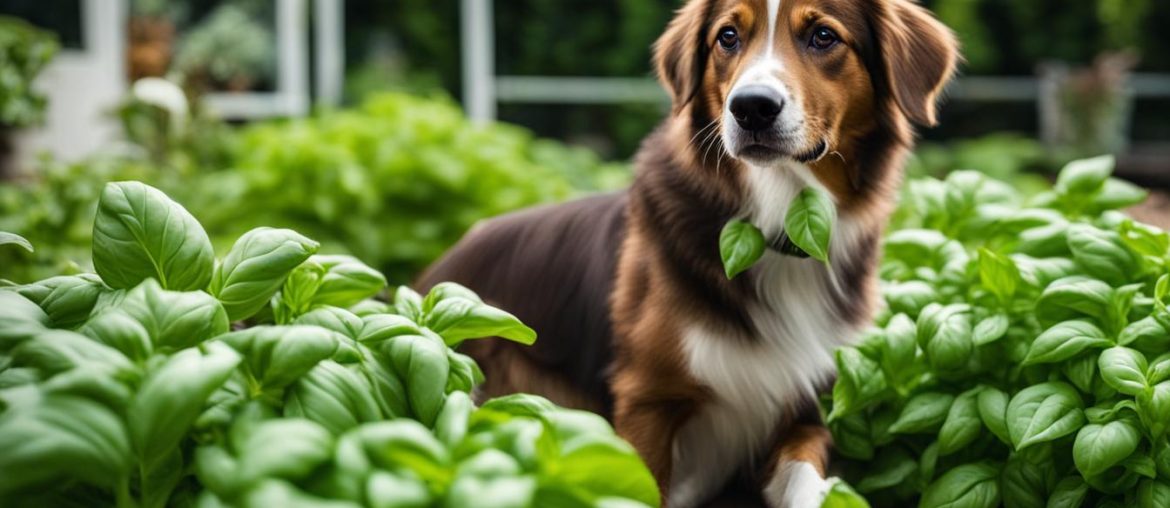Basil is a popular herb used in human cuisine, but can dogs safely consume it? In this comprehensive guide, I will explore the safety and potential benefits of feeding basil to dogs. It’s important for pet owners to be aware of which herbs are safe for their four-legged friends, and basil is one that can be incorporated into a dog’s diet.
Key Takeaways:
- Basil can be safely consumed by dogs in moderation.
- Feeding dogs basil can provide nutritional benefits such as vitamins A, C, and K.
- Basil has antioxidant properties that can protect cells from oxidative damage.
- It’s essential to consult with a veterinarian before making any dietary changes for your dog.
- When incorporating basil into your dog’s diet, start with a small amount and gradually increase the serving size.
What is Basil and its Common Varieties?

Basil, scientifically known as Ocimum basilicum, is an annual herbaceous plant that is native to tropical regions in Asia and Africa. It is a member of the mint family and has vibrant green leaves and delicate flowers. There are several common varieties of basil, each with its own distinct flavor profile and culinary uses.
Basil is a versatile herb that is widely used in various cuisines around the world. Its aromatic leaves add a fresh and vibrant flavor to dishes, making it a popular choice for both savory and sweet recipes. Here are some of the most common varieties of basil:
- Sweet basil: This is the most popular variety of basil and is often used in Italian cuisine. It has a slightly peppery and clove-like flavor.
- Thai basil: This variety has a strong licorice-like aroma and is commonly used in Thai and Vietnamese dishes. It adds a unique and bold flavor to stir-fries, curries, and noodle dishes.
- Lemon basil: As the name suggests, this basil variety has a citrusy fragrance and flavor. It is often used in salads, desserts, and herbal teas.
Each variety of basil has its own unique taste and can add depth and complexity to dishes. Whether you’re making a classic Italian pasta sauce, a spicy Thai curry, or a refreshing summer salad, basil is a versatile herb that can elevate the flavors of your culinary creations.
| Variety | Flavor Profile | Culinary Uses |
|---|---|---|
| Sweet Basil | Slightly peppery and clove-like | Italian dishes, pesto, Caprese salad |
| Thai Basil | Strong licorice-like aroma | Thai and Vietnamese dishes, stir-fries, curries |
| Lemon Basil | Citrusy fragrance and flavor | Salads, desserts, herbal teas |
Nutritional Value of Basil for Dogs
Basil not only enhances the flavor of dishes, but it also offers numerous nutritional benefits for dogs. This aromatic herb is rich in essential vitamins and minerals that contribute to a dog’s overall health and well-being. Some of the key nutrients found in basil include:
- Vitamin A: Supports eye health, immune function, and skin health.
- Vitamin C: Acts as an antioxidant, protecting cells from damage and supporting immune function.
- Vitamin K: Aids in blood clotting and helps maintain healthy bones.
- Calcium: Essential for strong bones and teeth.
- Potassium: Important for maintaining proper muscle and nerve function.
These vitamins and minerals play vital roles in a dog’s overall health and can contribute to their growth, development, and overall vitality. Incorporating basil into a dog’s diet can help ensure they receive these essential nutrients.
“Basil is a nutrient-dense herb that can provide a range of health benefits for dogs when included in their diet.”
Sample Table: Nutritional Value of Basil (per 100g)
| Nutrient | Amount |
|---|---|
| Vitamin A | 2640 IU |
| Vitamin C | 18 mg |
| Vitamin K | 414.8 µg |
| Calcium | 177 mg |
| Potassium | 295 mg |
Note: The values mentioned are approximate and may vary depending on the variety of basil and its growing conditions.
Potential Benefits of Basil for Dogs

Basil offers several potential benefits for dogs, making it a valuable addition to their diet. Here are some of the key advantages of incorporating basil into your furry friend’s meals and treats:
- Antioxidant Properties: Basil contains antioxidants that can protect your dog’s cells from oxidative damage. These antioxidants help to neutralize harmful free radicals and promote cellular health in dogs.
- Anti-inflammatory Effects: The anti-inflammatory properties of basil may help reduce inflammation in dogs with conditions such as arthritis. By incorporating basil into their diet, you can potentially alleviate discomfort and improve their overall joint health.
- Digestive Aid: Basil can act as a digestive aid for dogs by stimulating the production of digestive enzymes. This can help improve digestion and nutrient absorption, ultimately promoting a healthy gastrointestinal system.
Please be aware that while basil can offer these potential benefits, it should be introduced gradually and in moderation. Every dog is unique, and some may have allergies or sensitivities. As with any dietary change, it’s crucial to consult with your veterinarian before incorporating basil into your dog’s diet.
To summarize, basil can provide various advantages for dogs, including antioxidant properties, anti-inflammatory effects, and digestive aid. However, it’s important to exercise caution, start with small amounts, and monitor your dog’s response. By following these guidelines and seeking guidance from a veterinarian, you can safely introduce basil as a nutritious addition to your dog’s meals and treats.
Consulting with Your Veterinarian
When it comes to making dietary decisions for your beloved dog, it’s always best to consult with a veterinarian. Seeking guidance from a professional ensures that you are making informed choices that are tailored to your dog’s specific needs. Your veterinarian can provide personalized advice based on factors such as your dog’s age, breed, health conditions, and any dietary restrictions or allergies they may have. By working closely with your veterinarian, you can ensure that incorporating basil into your dog’s diet is appropriate and safe.
During your consultation, be prepared to discuss your intentions of including basil in your dog’s meals and treats. Provide your veterinarian with information about the form of basil you plan to use, whether it’s fresh basil leaves or dried basil. They can advise you on the appropriate serving sizes and help you determine the best way to introduce basil into your dog’s diet.
Additionally, your veterinarian can address any concerns you may have regarding potential allergies or sensitivities to basil. They can educate you on the signs to watch out for and advise you on how to monitor your dog’s response once basil is introduced into their diet. With the guidance of a veterinarian, you can ensure that you are taking the necessary precautions to keep your dog safe and healthy.
To summarize, consulting with a veterinarian is crucial when it comes to incorporating basil into your dog’s diet. They can provide expert advice, personalized recommendations, and answer any questions or concerns you may have. Remember, your veterinarian is there to support you and your dog’s well-being, so don’t hesitate to seek their guidance.
Suitable Forms of Basil for Dogs

When it comes to incorporating basil into your dog’s diet, there are different forms of this herb that you can offer. Both fresh and dried basil can provide nutritional benefits to your four-legged friend.
Fresh Basil: Fresh basil leaves are a great option for dogs. They not only provide the nutritional benefits of this herb but also offer a pleasant aroma that can enhance the flavor of your dog’s meals. You can finely chop fresh basil leaves and mix them into your dog’s regular food or use them as a garnish.
Dried Basil: Dried basil can be used as an alternative when fresh basil is not readily available. It still retains many of the herb’s beneficial properties and can be incorporated into homemade dog treats or sprinkled over your dog’s food. Just make sure to use a moderate amount, as dried herbs are more concentrated.
| Type of Basil | Form | Usage |
|---|---|---|
| Fresh Basil | Leaves | Chop and mix into meals or use as a garnish |
| Dried Basil | Flakes | Sprinkle over food or incorporate into homemade treats |
| Powder | Use in recipes or mix with other ingredients |
Regardless of the form you choose, it is important to ensure that the basil is clean and free from any pesticides or contaminants before serving it to your dog. This can be achieved by washing fresh basil thoroughly or purchasing organic options.
Remember to introduce basil gradually into your dog’s diet and monitor their response. If you notice any signs of allergies or sensitivities, such as itching, vomiting, or diarrhea, discontinue feeding basil and consult with your veterinarian.
Recommended Basil Serving Sizes for Dogs
When it comes to incorporating basil into your dog’s diet, it’s important to determine the appropriate serving size. The recommended amount of basil for dogs depends on factors such as their size, weight, and overall health. Starting with a small amount and gradually increasing the serving size is key to ensure your dog tolerates it well.
To give you a general idea, here are some serving size guidelines for dogs:
- Small Dogs (up to 20 pounds): Start with 1-2 fresh basil leaves or a pinch of dried basil.
- Medium Dogs (20-50 pounds): Begin with 2-3 fresh basil leaves or a small sprinkle of dried basil.
- Large Dogs (50+ pounds): Introduce 3-4 fresh basil leaves or a larger pinch of dried basil.
Please be aware that these serving sizes are just a starting point. Every dog is different, so it’s crucial to monitor their response after introducing basil into their diet. Watch out for any signs of digestive upset, allergies, or sensitivities. If you have concerns or if your dog experiences any adverse effects, it’s always best to consult with a veterinarian for personalized advice.
| Dog Size | Serving Size |
|---|---|
| Small Dogs (up to 20 pounds) | 1-2 fresh basil leaves or a pinch of dried basil |
| Medium Dogs (20-50 pounds) | 2-3 fresh basil leaves or a small sprinkle of dried basil |
| Large Dogs (50+ pounds) | 3-4 fresh basil leaves or a larger pinch of dried basil |
Remember, moderation is key when it comes to feeding basil to your furry friend. By following these serving size recommendations and closely monitoring your dog’s response, you can safely enjoy the potential benefits that basil can offer to your dog’s overall health and well-being.
Incorporating Basil in Dog Meals and Treats

Basil is a versatile herb that can add flavor and nutrition to your dog’s meals and treats. Here are some creative ways to incorporate basil into your dog’s diet:
Incorporating Fresh Basil:
- Chop fresh basil leaves into small pieces and sprinkle them over your dog’s food as a tasty garnish.
- Mix finely chopped fresh basil with other herbs and spices to create a homemade seasoning for your dog’s meals.
- Blend fresh basil leaves with other dog-friendly ingredients, such as yogurt or pumpkin, to make a delicious and nutritious topping for your dog’s food.
Basil-Infused Oils:
You can create a homemade basil-infused oil to drizzle over your dog’s food for an extra burst of flavor. Here’s how:
- Add a handful of fresh basil leaves to a jar.
- Pour olive oil or coconut oil over the basil leaves, making sure they are fully submerged.
- Seal the jar tightly and let it sit in a cool, dark place for at least a week to allow the flavors to infuse.
- Strain the oil to remove the basil leaves.
- Store the basil-infused oil in a glass container in the refrigerator.
When using the basil-infused oil, remember to use it sparingly to avoid adding too much fat to your dog’s diet.
Homemade Basil Dog Treats:
If you enjoy baking for your dog, homemade basil dog treats can be a delicious and healthy option. Here’s a simple recipe to get you started:
“Basil Bites”
Ingredients:
- 1 cup whole wheat flour
- 1/4 cup fresh basil, finely chopped
- 1/4 cup water or low-sodium chicken broth
- 1 tablespoon olive oil
Instructions:
- Preheat your oven to 350°F (175°C) and line a baking sheet with parchment paper.
- In a mixing bowl, combine the whole wheat flour and fresh basil.
- Add the water or chicken broth and olive oil to the bowl and mix until a dough forms.
- Roll out the dough on a lightly floured surface to about 1/4-inch thickness.
- Use a cookie cutter to cut out shapes or simply cut the dough into small squares.
- Place the treats on the prepared baking sheet and bake for 15-20 minutes, or until golden brown.
- Allow the treats to cool completely before serving them to your dog.
Store the basil dog treats in an airtight container in the refrigerator for up to two weeks.
Remember to always introduce new foods or treats gradually and monitor your dog for any adverse reactions. If you have any concerns or questions, consult with your veterinarian before incorporating basil into your dog’s diet.
Precautions for Feeding Basil to Dogs

While basil is generally safe for dogs, it’s important to exercise precautions when incorporating it into their diet. Here are some key considerations:
1. Moderation in Feeding Basil
As with any new food, it’s important to introduce basil to your dog’s diet gradually and in moderation. Feeding excessive amounts of basil can lead to digestive upset and discomfort. Start with small servings, such as a few leaves or a pinch of dried basil, and observe how your dog reacts. If there are no adverse effects, you can gradually increase the serving size over time.
2. Observing for Allergies or Sensitivities
While basil is generally well-tolerated by dogs, it’s essential to observe your pet for any signs of allergies or sensitivities. Watch out for symptoms such as itching, skin rashes, gastrointestinal disturbances, or difficulty breathing. If you notice any adverse reactions after feeding basil, discontinue its use and consult with your veterinarian.
In addition, it’s important to ensure that the basil you provide is fresh, clean, and free from any pesticides or contaminants. Choose organic basil whenever possible, or thoroughly wash and inspect the leaves before offering them to your dog.
By taking these precautions and monitoring your dog’s response, you can safely incorporate basil as a nutritious addition to their diet. Remember, consulting with a veterinarian is always recommended before making any significant changes to your dog’s food.
Is Basil Toxic to Dogs?

One question that often arises when discussing feeding basil to dogs is whether basil is toxic to them. Fortunately, basil is not toxic to dogs. In fact, it can offer potential health benefits when incorporated into their diet. However, it’s important to be cautious of basil-based foods that may contain harmful ingredients for dogs. Some basil-based products, such as pesto or sauces, may include garlic or onions, which can be toxic to dogs. When preparing homemade recipes with basil, it’s best to avoid adding garlic or onions to ensure the safety of your furry friend.
In order to keep your dog safe and healthy, it’s important to read labels carefully and avoid any basil-based products that may contain harmful ingredients. By being mindful of the ingredients in basil-based foods, you can ensure that your dog receives the nutritional benefits of basil without any potential risks. Remember, always consult with your veterinarian before making any significant changes to your dog’s diet.
Table: Examples of Harmful Ingredients in Basil-Based Foods
| Ingredients | Potential Harm to Dogs |
|---|---|
| Garlic | Toxic to dogs, can cause gastrointestinal upset and damage to red blood cells |
| Onions | Toxic to dogs, can cause anemia, gastrointestinal upset, and damage to red blood cells |
| Salt | Excessive consumption can lead to sodium ion poisoning and electrolyte imbalances in dogs |
| Sugar | Can contribute to obesity, dental issues, and other health problems in dogs |
| Artificial sweeteners | Some artificial sweeteners, such as xylitol, are highly toxic to dogs and can cause life-threatening complications |
When it comes to feeding basil to your dog, always prioritize their safety and well-being. By avoiding harmful ingredients and consulting with your veterinarian, you can incorporate basil as a nutritious addition to your dog’s meals and treats, enhancing their overall diet and potentially reaping the benefits that this herb has to offer.
Wrapping Up
To summarize, feeding basil to dogs can be a safe and beneficial addition to their diet. Basil is rich in essential vitamins and minerals, offers antioxidant properties, anti-inflammatory effects, and can serve as a digestive aid. However, it’s crucial to exercise caution and moderation.
Before incorporating basil into your dog’s meals, it’s vital to consult with a veterinarian. They can provide personalized advice based on your dog’s specific needs and health status. Additionally, it’s important to monitor your dog’s response when introducing basil and observe for any signs of allergies or sensitivities.
By following these guidelines, you can safely include basil as a nutritious ingredient in your dog’s meals and treats. Remember to start with a small serving size and gradually increase it over time. With the proper precautions and veterinary guidance, you can provide your dog with the potential benefits of basil while ensuring their overall well-being.
FAQ
Can dogs eat basil?
Yes, dogs can safely consume basil in moderate amounts.
What is basil and its common varieties?
Basil is an annual herbaceous plant that belongs to the mint family. Common varieties include sweet basil, Thai basil, and lemon basil.
What is the nutritional value of basil for dogs?
Basil is packed with essential vitamins and minerals, including vitamins A, C, and K, calcium, and potassium.
What are the potential benefits of basil for dogs?
Basil has antioxidant properties, anti-inflammatory effects, and can aid digestion in dogs.
Should I consult with my veterinarian before feeding basil to my dog?
Yes, it is important to consult with your veterinarian before making any dietary changes for your dog, including the addition of basil.
What forms of basil are suitable for dogs?
Fresh basil leaves and dried basil can be offered to dogs.
How much basil should I feed my dog?
Start with a small amount, such as a few leaves or a pinch of dried basil, and gradually increase the serving size over time. Consult with your veterinarian for specific recommendations.
How can I incorporate basil into my dog’s meals and treats?
You can prepare a homemade basil-infused oil or find recipes for homemade dog treats that include basil as an ingredient.
Are there any precautions when feeding basil to dogs?
Yes, feed basil in moderation and observe your dog for any signs of allergies or sensitivities. Discontinue feeding basil if any adverse effects occur.
Is basil toxic to dogs?
Basil itself is not toxic to dogs, but be cautious of basil-based foods that may contain harmful ingredients like garlic or onions.






